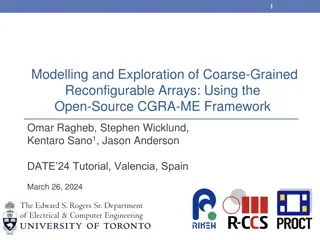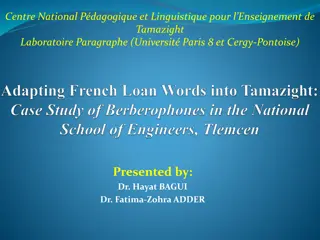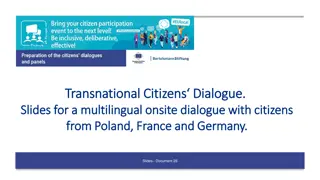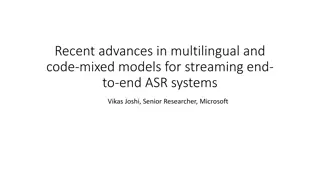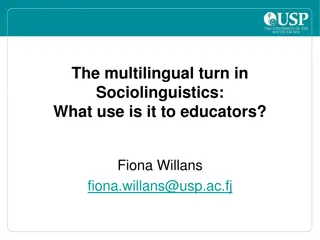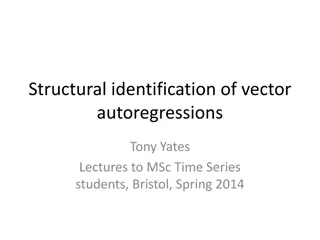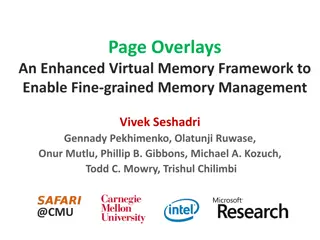Fine-Grained Language Identification Using Multilingual CapsNet Model
This study explores fine-grained language identification through a multilingual CapsNet model, addressing challenges such as short audio snippets, multiple languages, noise, limited training data, and non-class identification. The dataset includes various languages like Arabic, Bengali, Chinese, English, Hindi, Turkish, Spanish, Japanese, Punjabi, and Portuguese, gathered from sources like YouTube for tasks such as language identification and non-class tests.
Download Presentation

Please find below an Image/Link to download the presentation.
The content on the website is provided AS IS for your information and personal use only. It may not be sold, licensed, or shared on other websites without obtaining consent from the author.If you encounter any issues during the download, it is possible that the publisher has removed the file from their server.
You are allowed to download the files provided on this website for personal or commercial use, subject to the condition that they are used lawfully. All files are the property of their respective owners.
The content on the website is provided AS IS for your information and personal use only. It may not be sold, licensed, or shared on other websites without obtaining consent from the author.
E N D
Presentation Transcript
Fine-grained Language Identification with Multilingual CapsNet Model Mudit Verma1 & Arun Balaji Buduru2 1.Arizona State University, USA 2.IIIT-Delhi, India
Need Emergency Call Routing Services Intelligent Voice Assistants Conversational AI Speech is the easiest form of communication for humans.
Trends Language Embeddings (i-vector) Use Hand Crafted Features ( & Phoneme Detection) Mel Frequency Cepstral Coefficients Spectrograms P. Verma and P. K. Das, i-vectors in speech processing applications: a survey, International Journal of Speech Technology, vol. 18, no. 4, pp. 529 546, Dec 2015. [Online]. Available: https://doi.org/10.1007/s10772-015-9295-3
Trends View it as a classification Problem SVM / GMM / HMM Logistic Regression Fully connected Neural Networks BLSTM CNN (based on VGG)
Issues Manual Feature Extraction is hard Data Requirements Robustness to Noise
Fine-Grained LID Problem Characteristics : 1. Short Spoken Audio Snippets (5s-10s) 2. Multiple Languages 3. Noise 4. Exiguous Train Data 5. Trivial Data collection 6. Non-Class Identification 7. Multilingual
Dataset - Languages Arabic - AR Bengali - BE Chinese(Mand.) - CH English - EN Hindi - HI Turkish Spanish Japanese Punjabi Portuguese *used for Language Identification **used for Non-Class Tests
Dataset - Languages Arabic - AR Bengali - BE Chinese(Mand.) - CH English - EN Hindi - HI Turkish Spanish Japanese Punjabi Portuguese *used for Language Identification **used for Non-Class Tests Deal with Indian Languages with more popular languages used for LID Task Diverse set of languages Exiguous Data requirements help with regional LID
Dataset - Collection Type : Audio recordings of local and global news, interviews, speeches etc. Source : YouTube Data Size : 100 hrs / language for LID Task ( -> 500 hrs total) 30 hrs / language for Non-Class Task (-> 150 hrs total) Train / Test Size : 70-30 for LID 20-10 for Non-Class
Dataset - Characteristics Trivial and Easy Data Collection Various Types of Noise : 1. Heard/Not-Understandable (spoken language is not understood) Background noise of cheers, slogans 2. Heard/Understandable (multiple spoken languages) Interviews/News reporting in multiple languages 3. Unheard (noise but not spoken language) Chimes/Mic Noise
Dataset - Processing .wav format Spectrogram Representation Discretize using Hann window & 129 frequency bins 8-bit grayscale
Work Handle Problem in Image Domain Use Capsule Networks (CapsNet) for classification Compare with variants of CNN CNN + Bi-GRU CNN + Bi-LSTM CNN + Bi-GRU + Attention Test deeper variant of CapsNet Verify Non-Class Detection (Out of Distribution Samples)
Image Domain Use Spectrogram Mel-Frequency Coeff. Cepstrum does not help much.
CapsNets - Theory CNNs are great but they have a problem. They have : Positional Invariance (Thanks to Pooling layers) Tolerant to ViewPoint Invariance S. Sabour, N. Frosst, and G. E. Hinton, Dynamic routing between capsules, in Advances in Neural Information Pro- cessing Systems, 2017, pp. 3856 3866.
CapsNets - Theory Solves the Picasso Problem CapsNets replace scalar-output feature detectors with vector-output capsules and max-pooling with routing-by-agreement. Because capsules are independent, when multiple capsules agree, the probability of correct detection is much higher S. Sabour, N. Frosst, and G. E. Hinton, Dynamic routing between capsules, in Advances in Neural Information Pro- cessing Systems, 2017, pp. 3856 3866.
CapsNets - Theory Solves the Picasso Problem CapsNets replace scalar-output feature detectors with vector-output capsules and max-pooling with routing-by-agreement. Because capsules are independent, when multiple capsules agree, the probability of correct detection is much higher
CapsNets Architecture Bottleneck
Baseline CNN-(RNN)- Attention C. Bartz, T. Herold, H. Yang, and C. Meinel, Language identification using deep convolutional recurrent neural net- works, in International Conference on Neural Information Processing. Springer, 2017, pp. 880 889.
Non-Class Detection Verification Step. Is CapsNet more robust* than baseline? Thresholding Mechanism *robustness here is over several languages.
Results CapsNet is bad. Or is it?
Results ROC Curve & AUC Score for Languages (1-5) by CapsNet (with Midcaps Layers) 5 second audio input. Left : Test Data. Right : Train Data.
Results ROC Curve & AUC Score for Languages (1-5) by Bi-GRU 10 second audio input. Left : Test Data. Right : Train Data.
See a pattern? Results
See a pattern? HI -> AR - > BE ~ CH > EN Results
See a pattern? HI -> AR - > BE ~ CH > EN Should we be expecting this order? Results
Results Non Class Detection for languages (6-10)
Results Why is Japanese low? Why is Punjabi high? Portuguese & Spanish Turkish ~ Arabic Non Class Detection for languages (6-10)
Results CapsNet is Multilingual S. Toshniwal, T. N. Sainath, R. J. Weiss, B. Li, P. Moreno, E. Weinstein, and K. Rao, Multilingual speech recognition with a single end-to-end model, in 2018 IEEE Interna- tional Conference on Acoustics, Speech and Signal Processing (ICASSP). IEEE, 2018, pp. 4904 4908.
Future Work Recurrent Layers with CapsNet NAS over CapsNet architectures Non Class Detection



